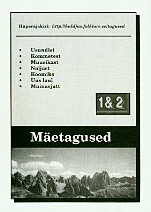Tubjaku Kosterkini loitsud
Tubjaku Kosterkin's incantations
Author(s): Aado LintropSubject(s): Customs / Folklore
Published by: Eesti Kirjandusmuuseum
Summary/Abstract: When the shaman felt the spirit's arrival, he began to sing on its melody. A song consisted from the fragments of different length (from couple to several hundreds of lines), each started with words tamany, tamany - a sign that the shaman, who between the fragments spoke `his own words' for commenting the songs, will again perform the speech of his helping spirit. Tuobtusi repeated each line of the song. Nobody could not speak with the spirits on his own initiative, but had to wait till the spirit will ask him a question. After that the shaman stopped singing and - if necessary - explained the question. If the person whom the question was addressed did not understand or his answer did not satisfy the shaman/the helping spirit, the shaman began a new song fragment, in which he tried to phrase it in other words. The long fragments (119 lines at the first and 231 lines at the second séances) are distinctively monologuous, containing the lines referring to the inner reasoning of the shaman/helping spirit: at the beginning I thought to say, after that I thought to say, then I thought to say, thereafter I thought to say, on that day I thought to say, shortly I thought to say. The short fragments are dialogical, containing a guesswork about some matter related with an addressee and a prediction - what will happen, if the shaman is right. On the base of published materials I can assure that these sorts of guessing or divination were common to all Nganasan shaman séances. At the beginning of a rite the so-called quest for the right path had to convince a shaman and an audience that the shaman, together with his helping spirits, is moving towards the purpose of the séance by the right way, all of them powerful for acting. Nobody must lie to a shaman nor must one assure the wrong guesswork of a shaman. According to the belief, giving the false information amounts to misleading a shaman. The latter could be fatal to a shaman and his community. At the end of successful rite a shaman had been accustomed to foretell the future by request of a participant. The divination, which did not differ formally from seeking the right path, may have accompanied with casting lots by means of a drumstick. In addition to the function of foretelling, the short/dialogical fragments are kind of magic - each of them is an attempt to act on the life of an addressee. From the viewpoint of a shaman the principle of such magic will be following: if my words happen to be right then you are going strong. The long fragments are more poetic, and therefore less understandable than short ones. The shaman does not address them directly to anybody, though he may say the names of participants or relatives. At the first séance the words at the beginning I thought to say are followed by the characterisation of the situation.
Journal: Mäetagused. Hüperajakiri
- Issue Year: 1996
- Issue No: 01-02
- Page Range: 30-43
- Page Count: 14
- Language: Estonian

